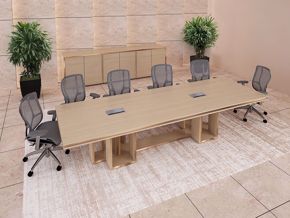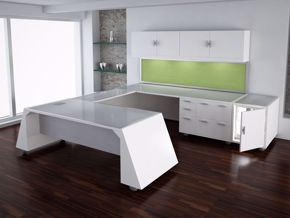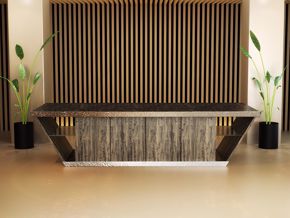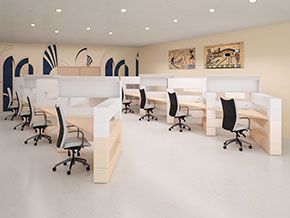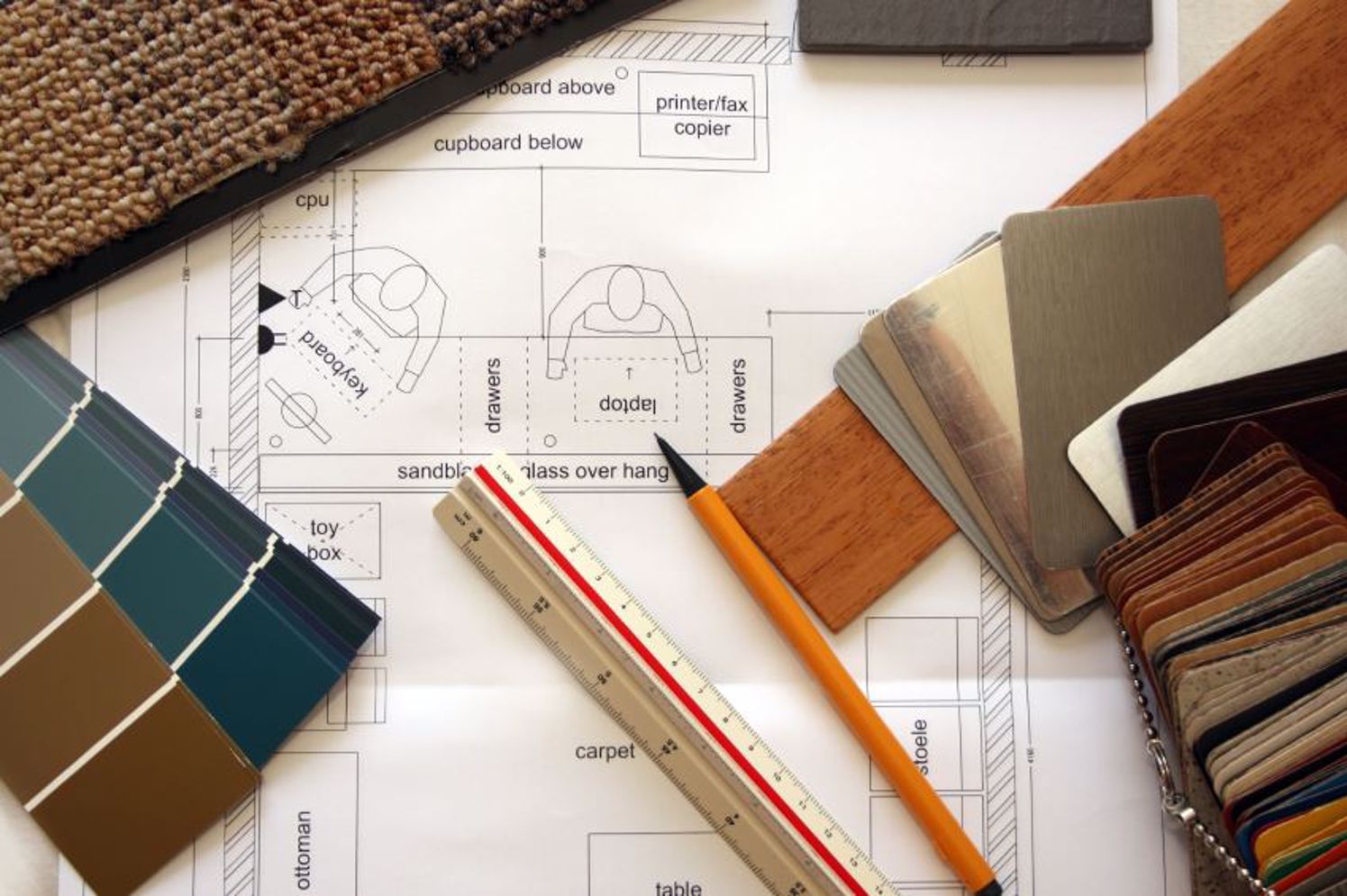Whether you are occupying office space in your own building or renting space from an outside source, your reception area is an important zone to consider—and it requires thought and planning. This part of your office is where your customers, vendors, and employees walk through first—and leave last. Selecting reception furniture that creates a pleasing, welcoming environment while supporting function and everyday use is instrumental in the creation of a workspace that suits your company’s needs.
- Measure your space. Use a measuring tape or yardstick to measure all dimensions, columns, angles, and architectural encumbrances (like alcoves) in your reception area. Few rooms conform to basic length and width without jettisons.
- Plan your reception space. You can use formal grid paper, or sketch it out on notebook paper or plain printer paper. A trick I learned years ago involves making grid paper electronically in your Excel computer program. Decide which functions your room needs to employ and how much space you can spare for furniture, and sketch out a few different ways that furniture can be arranged in your room to fit comfortably. Leave yourself about three feet of space between furniture pieces like chairs and tables, and possibly more between your reception desk and other furniture. Smaller spaces between furniture pieces will make your reception area feel crowded and difficult to navigate without obstruction.
- Check your reception area doorways. Measure the width of your reception area doorways, hallways, turning points, and elevators to avoid problems when receiving your furniture. The last thing you want is to spend effort and thought planning your reception area—only to find out, in the end, that you can’t get your furniture into your space. If you are purchasing your reception furniture from 90 Degree Office Concepts, you can ask your furniture design agent to build your furniture to fit your space requirements.
- Lay out your furniture physically. After determining how much space you can spare for furniture and where you want potential pieces to go, mark those spaces on the floor to get a better visual. Use painter’s tape, or spread out sheets of newspaper.
- Plan how your reception area is to be used. Your reception area may be used as a waiting space to visit a team member, a transaction area for customers, an information center, or a showroom for products and services. Because yours is a commercial environment, you will need your reception furniture to be well-made, stain-resistant, and design-specific to your room’s function. Conversely, if your room is going to be used for the occasional visitor who will be there only for a short visit, your furniture can be more delicate.
- Plan around your reception area’s natural appointments. Some reception areas are endowed with structural design elements that may or may not help you select the type of reception furniture best-suited to your workspace. For example, if you have a brick wall in your entryway, you may decide on a modern reception desk featuring natural materials (like wood or stone) to complement existing elements, as opposed to a look that is flat or plain. Conversely, if your office is in a modern high-rise overlooking the city with large windows, you may opt for a different approach to your selection.
Selecting Your Reception Furniture
- Begin at the beginning. Most reception areas have a reception desk, seating, end table(s), and a coffee table. Approach your process by deciding on key pieces of furniture first, then adding extra pieces: lamps, showcases, bookcases, and accent pieces.
- Buy quality pieces. Look for a top-quality reception desk: one made of sturdy wood and reinforced with screws, glue, and solid brackets as opposed to the fabricated, knocked-down pieces in the marketplace. High-quality reception desks will cost a little more, but they certainly last longer and will leave your customers with a better impression of your company.
- Search for better-quality, stain-resistant fabrics for seating. Well-appointed, first-class fabrics for your seating will keep your clients feeling more comfortable while waiting, and will have a longer life-cycle than lower-quality fabrics. Commercial-grade, stain-resistant fabrics are particularly worthwhile if you plan on serving beverages or snacks to your clients as they arrive. Dropsies can happen to any visitor. Protecting your reception furniture is a good long-term investment.
- Buy seat cushions made of wrapped foam. Commercial-grade seating is usually made of foam. Foam is comfortable and durable. Sometimes, you may be tempted to bring residential seating into your reception area. Those cushions are sometimes filled with down; however, down customarily breaks down and wears quickly.
- Harmonize your reception furniture. Individually, your reception area furniture should act as a counterpart to your other furnishings. Without this, your reception area will look disorganized and out of sync. It may be better for a novice to keep to one central theme. If you select modern as a theme, then make all your pieces fit in with that same theme.
- Recognize your themes. Interior design themes can be separated in many different ways, including modern, casual, contemporary Old World, and traditional.
- Modern and contemporary reception furniture has smooth, clean lines. Whites, cream colors, and beige often make their way to the forefront of this color range. Materials like metal, gloss laminates, glass, and shiny black or white lacquer are employed a lot. A range of woods can also be used under the umbrella of modern and contemporary.
- Traditional furniture has that sophisticated look. It imparts a feeling of formality. Reception furniture will have moldings on vertical panels and rolled arms on seating, and often features deep reds and darker wood.
- Casual reception furniture is welcoming and cozy. Many pieces have an easy, unorganized way about them.
- Old World furniture marries styles from French, Spanish, and Italian designs. Pastoral antique pieces are particularly suitable, and you should look for deep, earthy colors.
- Opt for individual seating in place of a sofa, if you have a business where people don’t arrive together. People generally want personal space when they don’t know each other or are not close. Loveseats and sofas typically provide seating for two to three individuals, keeping them nearby. If you have a small reception area and your business does not lend itself to couples, it’s safer to use chairs in place of community seating.
- Use accent pieces as your reception space dictates. Art, lamps, and vases can add a special zip to your reception area, but if you overrun your entryway with a lot of stuff, particularly if it’s a small area, your room will feel crowded.
Tips
- Do not overuse accessories in your entryway. It is important to consider the feeling your reception area imparts to your guests. A piece or two to inspire interest or open a conversation can be enough. A uniquely-styled modern reception desk or fascinating piece of art can add personality to your space. The idea behind reception area design is to make the room appealing and to make it feel good, so it can complement your business and impress upon your visitors the value of your company to them.
- 90 Degree Office Concepts will help you avoid mistakes in material and finish selections by sending out color samples before the finishes are applied on your furniture. Ask your furniture design coordinator for any help you may need to put together furniture that will make your reception area work for your business. Getting a professional involved in the process may take a little extra time; however, the extra time you spend getting it right will save you time and money in the long run.
- Measure your space many times. It is, without question, essential to the outcome of your reception design that you know the accurate, precise dimensions of your workspace, as well as the perfect sizes of furniture you intend to buy. Otherwise, you may end up purchasing pieces that do not actually fit inside your room. For this reason, 90 Degree Office Concepts will give you exact measurements for all your furniture.
- Select flooring, wall colors, and finishing details that harmonize with your choice of reception furniture. The way your reception area looks, feels, and works with your business is essential to what your visitor thinks about your business when they arrive…and when they leave.


